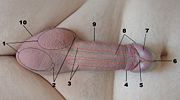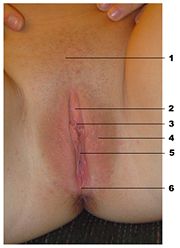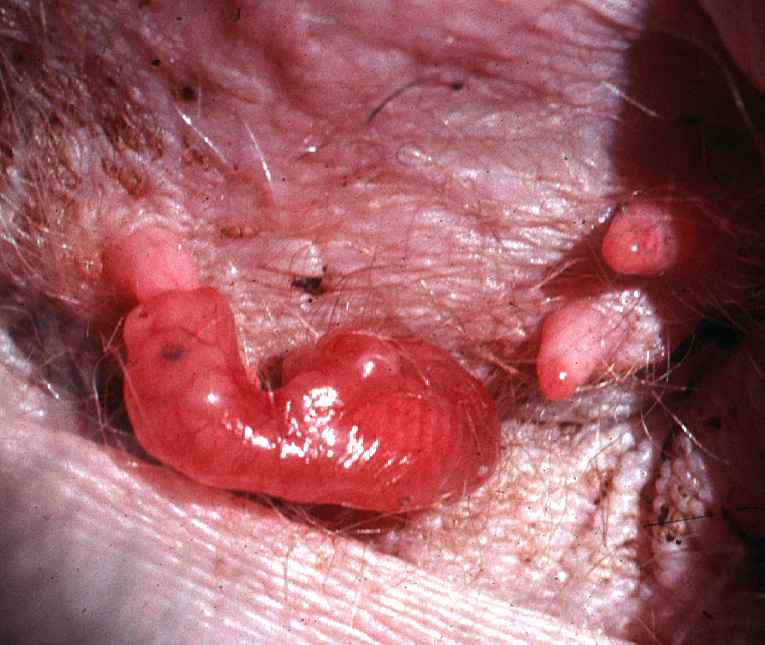Reproductive system
Editor-In-Chief: C. Michael Gibson, M.S., M.D. [1]
The reproductive system is a system of organs within an organism which work together for the purpose of reproduction. Many non-living substances such as fluids, hormones, and pheromones are also important accessories to the reproductive system.[1] Unlike most organ systems, the sexes of differentiated species often have significant differences. These differences allow for a combination of genetic material between two individuals, which allows for the possibility of greater genetic fitness of the offspring.[2]
The major organs of the human reproductive system include the external genitalia (penis and vulva) as well as a number of internal organs including the gamete producing gonads (testicles and ovaries). Diseases of the human reproductive system are very common and widespread, particularly communicable sexually transmitted diseases.[3]
Most other vertebrate animals have generally similar reproductive systems consisting of gonads, ducts, and openings. However, there is a great diversity of physical adaptations as well as reproductive strategies in every group of vertebrates.
Human reproductive system
Human reproduction takes place as internal fertilization by way of intercourse. During this process, the erect penis of the male is inserted into the female's vagina until the male ejaculates semen, which contains sperm, into the female's vagina. The sperm then travels through the vagina and cervix into the uterus or fallopian tubes for fertilization of the ovum. Upon successful fertilization and implantation, gestation of the foetus then occurs within the female's uterus for approximately nine months, this process is known as pregnancy in humans. Gestation ends with birth, the process of birth in known as labor. Labor consists of the muscles of the uterus contracting, the cervix dilating, and the baby passing out the vagina. Human's babies and children are nearly helpless and require high levels of parental care for many years. One important type of parental care is the use of the mammary glands in the female breasts to nurse the baby.[4]
Humans have a high level of sexual differentiation. In addition to differences in nearly every reproductive organ, numerous differences typically occur in secondary sexual characteristics and in sexual and parental behaviours.
Male reproductive system

The human male reproductive system is a series of organs located outside of the body and around the pelvic region of a male that contribute towards the reproductive process. The primary direct function of the male reproductive system is to provide the male gamete or spermatozoa for fertilization of the ovum.
The major reproductive organs of the male can be grouped into three categories. The first category is sperm production and storage. Production takes place in the testes which are housed in the temperature regulating scrotum, immature sperm then travel to the epididymis for development and storage. The second category are the ejaculatory fluid producing glands which include the seminal vesicles, prostate, and the vas deferens. The final category are those used for copulation, and deposition of the spermatozoa (sperm) within the female, these include the penis, urethra, vas deferens, and Cowper's gland.
Major secondary sexual characteristics include: larger, more muscular stature, deepened voice, facial and body hair, broad shoulders, and development of an adam's apple. An important sexual hormone of males is androgen, and particularly testosterone.[5]
Female reproductive system

The human female reproductive system is a series of organs primarily located inside of the body and around the pelvic region of a female that contribute towards the reproductive process. The human female reproductive system contains three main parts: the vagina, which acts as the receptacle for the male's sperm, the uterus, which holds the developing fetus, and the ovaries, which produce the female's ova. The breasts are also an important reproductive organ during the parenting stage of reproduction.
The vagina meets the outside at the vulva, which also includes the labia, clitoris and urethra; during intercourse this area is lubricated by mucus secreted by the Bartholin's glands. The vagina is attached to the uterus through the cervix, while the uterus is attached to the ovaries via the fallopian tubes. At certain intervals, typically approximately every 28 days, the ovaries release an ovum, which passes through the fallopian tube into the uterus. The lining of the uterus, called the endometrium, and unfertilized ova are shed each cycle through a process known as menstruation.
Major secondary sexual characteristics include: a smaller stature, a high percentage of body fat, wider hips, development of mammary glands, and enlargement of breasts. Important sexual hormones of females include estrogen and progesterone.[5]
Production of gametes
The production of gametes takes place within the gonads through a process known as gametogenesis. Gametogenesis occurs when certain types of germ cells undergo meiosis to split the normal diploid number of chromosomes in humans (n=46) into haploids cells containing only 23 chromosomes.[6]
In males this process is known as spermatogenesis and takes place only after puberty in the seminiferous tubules of the testes. The immature spermatozoon or sperm are then sent to the epididymis where they gain a tail and motility. Each of the original diploid germs cells or primary spermatocytes forms four functional gametes which is each capable of fertilization.
In females gametogenesis is known as oogenesis and unlike males, all of the primary oocytes ever found in a female will be created in the ovarian follicles of the ovaries prior to birth. The final stages of ova production will then not resume until puberty.[6] In females, each of the original diploid germ cells or primary oocytes will form only one mature ovum, and three polar bodies which are not capable of fertilization.
Development of the reproductive system
The development of the reproductive system and urinary systems are closely tied in the development of the human fetus. Despite the differences between the adult male and female reproductive system, there are a number of homologous structures shared between them due to their common origins within the fetus. Both organ systems are derived from the intermediate mesoderm. The three main fetal precursors of the reproductive organs are the Wolffian duct, Müllerian ducts, and the gonad. Endocrine hormones are a well known and critical controlling factor in the normal differentiation of the reproductive system.[7]
The Wolffian duct forms the epididymis, vas deferns, ductus deferens, ejaculatory duct, and seminal vesicle in the male reproductive system and essentially disappears in the female reproductive system. For the Müllerian Duct this process is reversed as it essentially disappears in the male reproductive system and forms the fallopian tubes uterus, and vagina in the female system. In both sexes the gonad goes on to form the testes and ovaries, because they are derived from the same undeveloped structure they are considered homologous organs. There are a number of other homologous structures shared between male and female reproductive systems. However, despite the similarity in function of the female fallopian tubes and the male epididymis and vas deferens, they are not homologous but rather analogous structures as they arise from different fetal structures.
| Male organ | Female organ | Shared function |
|---|---|---|
| Cowper's gland | Bartholin's glands | Lubrication secretions. |
| Penis | Clitoris | Erectile tissue and sensation |
| Testes | Ovary | Gamete production |
| Prostate gland | Skene's gland | Ejaculatory fluid and sensation. |
Diseases of the human reproductive system
Like all complex organ systems the human reproductive system is affected by many diseases. There are four main categories of reproductive diseases in humans. They are: 1) genetic or congenital abnormalities, 2) cancers, 3) infections which are often sexually transmitted diseases, and 4) functional problems cause by environmental factors, physical damage, psychological issues, autoimmune disorders, or other causes. The best known type of functional problems include sexual dysfunction and infertility which are both broad terms relating to many disorders with many causes.
Specific reproductive diseases are often symptoms of other diseases and disorders, or have multiple, or unknown causes making them difficult to classify. Examples of unclassifiable disorders include Peyronie's disease in males and endometriosis in females. Many congenial conditions cause reproductive abnormalities but are better known for their other symptoms, these include: Turner syndrome, Klinefelter syndrome, Cystic fibrosis, and Bloom syndrome.[8]
It is also known that disruption of the endocrine system by certain chemical adversely affects the development of the reproductive system and can cause vaginal cancer.[9] Many other reproductive diseases have also been link to exposure to synthetic and environmental chemicals. Common chemicals with known links to reproductive disorders include: lead, dioxin, styrene, toluene, and pesticides.[10]
Examples of congenial abnormalities
- Kallmann syndrome - Genetic disorder causing decreased functioning of the sex hormone-producing glands caused by a deficiency of a hormone.
- Cryptorchidism - Absence of one or both testes from the scrotum.
- Androgen insensitivity syndrome - A genetic disorder causing people who are genetically male (i.e. XY chromosome pair) to develop sexually as a female due to an inability to utilize androgen.
- Intersexuality - A person who has genitalia or/and other sexual traits which are not clearly male or female.
Examples of cancers
- Prostate cancer - Cancer of the prostate gland.
- Breast cancer - Cancer of the mammary gland.
- Ovarian cancer - Cancer of the ovary.
- Penile cancer - Cancer of penis.
- Uterine cancer - Cancer of the uterus.
Examples of infections
- HIV - Infection by the retrovirus known as human immunodeficiency virus.
- Genital warts - Sexually transmitted infection caused by some sub-types of human papillomavirus (HPV).
- Herpes simplex - Sexually transmitted infection caused by a virus called herpes simplex virus (HSV) type 2
- Gonorrhea - Common sexually transmitted disease caused by the Gram-negative bacterium Neisseria gonorrheae
- Yeast infection - Infection of the vagina by any species of the fungus genus Candida.
- Pelvic inflammatory disease - Painful infection of the female uterus, fallopian tubes, and/or ovaries with associated scar formation and adhesions to nearby tissues and organs.
- Syphilis - Sexually transmitted infection caused by the bacterium Treponema pallidum.
- Pubic lice - Infection of the pubic hair by crab lice, Phthirius pubis.
- Trichomoniasis - Sexually transmitted infection by the single-celled protozoan parasite Trichomonas vaginalis.
Examples of functional problems
- Impotence - The inability of a male to produce or maintain an erection.
- Hypogonadism - A lack of function of the gonads, in regards to either hormones or gamete production.
- Ectopic pregnancy - When a fertilized ovum is implanted in any tissue other than the uterine wall.
- Inhibited sexual desire - A low level of sexual desire and interest.
- Female sexual arousal disorder - A condition of decreased, insufficient, or absent lubrication in females during sexual activity
- Premature ejaculation - A lack of voluntary control over ejaculation.
Other vertebrates
Template:Seealso Vertebrate animals all share key elements of their reproductive systems. They all have gamete producing organs or gonads. These gonads are then connected by oviducts to an opening to the outside of the body, typically the cloaca, but sometime to a unique pore such as a vagina or intromittent organ.
Mammals

Most mammal reproductive systems are similar, however, there are some notable differences between the "normal" mammal and humans. For instance, most mammalian males have a penis which is stored internally until erect, and most have a penis bone or baculum. Additionally, males of most species do not remain continually sexually fertile as humans do. Like humans, most groups of mammals have descended testicles found within a scrotum, however, others have descended testicles that rest on the ventral body wall, and a few groups of mammals, such as elephants, have undescended testicles found deep within their body cavities near their kidneys.[11][12]
Marsupials are unique in that they have two uterus, bifurcated, or two-parted, penises and vagina, and they typically develop their offspring in an external pouch containing teats to which their newborn young (joeys) attach themselves for post uterine development. Also, marsupials have a unique prepenial scrotum.[13]
The uterus and vagina are unique to mammals with no homologue in birds, reptiles, amphibians, or fish.[14] In place of the uterus the other vertebrate groups have an unmodified oviduct leading directly to a cloaca, which is a shared exit-hole for gametes, urine, and feces. Monotremes (i.e. platypus and echidnas), a group of egg-laying mammals, also lack a uterus and vagina, and in that respect have a reproductive system resembling that of a reptile.
Birds
Male and female birds have a cloaca, an opening through which eggs, sperm, and wastes pass. Intercourse is performed by pressing the lips of the cloacae together, which is sometimes known as the "cloacal kiss", during which time the male transfers his sperm to the female. A few species of birds (e.g. most waterfowl) have a intromittent organ which is known as a phallus that is analogous to the mammals' penis. The female lays amniotic eggs in which the young gestate. Unlike most vertebrates female birds typically have only one functional ovary and oviduct.[15] As a group, birds, like mammals, are noted for their high level of parental care.
Reptiles
Reptiles are almost all sexually dimorphic, and exhibit internal fertilization through the cloaca. Some reptiles lay eggs while others are viviparous (animals that deliver live young). Reproductive organs are found within the cloaca of reptiles. Most male reptiles have copulatory organs, which are usually retracted or inverted and stored inside the body. In turtles and crocodilians, the male has a single median penis-like organ, while male snakes and lizards each possess a pair of penis-like organs.

Amphibians
Most amphibians exhibit external fertilization of eggs, typically within the water, though some amphibians such as caecilians have internal fertilization.[16] All have paired, internal gonads, connected by ducts to the cloaca.
Fish
Fish exhibit a wide range of different reproductive strategies. Most fish however are oviparous and exhibit external fertilization. In this process, females use their cloaca to release a large quantities their gametes, called spawn, into the water and one or more males release "milt", a white fluid containing many sperm over the unfertilized eggs. Others species of fish are oviparous and have internal fertilization aided by pelvic or anal fins that are modified into an intromittent organ analogous to the human penis.[17] A small portion of fish species are either viviparous or ovoviviparous, and are collectively known as livebearers.[18]
Fish gonads are typically pairs of either ovaries or testes. Most fish are sexually dimorphic but some species are hermaphroditic or unisexual.[19]
Invertebrates
Invertebrates have an extremely diverse array of reproductive systems, the only commonality may be that they all lay eggs. Also, aside from cephalopods, and arthropods, nearly all other invertebrates are hermaphroditic and exhibit external fertilization.
Cephalopods
All cephalopods are sexually dimorphic and reproduce by laying eggs. Most cephalopods have semi-internal fertilization in which the male places his gametes inside the female's mantle cavity or pallial cavity to fertilize the ova found in the female's single ovary.[20] Likewise, male cephalopods have only a single teste. In the female of most cephalopods the nidamental glands aid in development of the egg.
The "penis" in most unshelled male cephalopods (Coleoidea) is a long and muscular end of the gonoduct used to transfer spermatophores to a modified arm called a hectocotylus. That in turn is used to transfer the spermatophores to the female. In species where the hectocotylus is missing, the "penis" is long and able to extend beyond the mantle cavity and transfers the spermatophores directly to the female.
Many cephalopods shed their gonads during reproduction, and thus only reproduce once. Most cephalopods die after reporducing. Females nautilus however, have the ability to regenerate their gonads, making them the only cephalopods to spawn once per year. The females in many cephalopod species exhibit some level of parental protection for their eggs.
See also
- Major systems of the human body
- Reproductive system disease
- Sexual reproduction
- Human sexuality
- Human sexual behavior
- Sex organ
- Plant sexuality
References
- ↑ Introduction to the Reproductive System. SEER's Training Website. U.S. National Cancer Institute's Surveillance, Epidemiology and End Results (SEER) Program.
- ↑ Reproductive System 2001 Body Guide powered by Adam
- ↑ STD's Today National Prevention Network, Center for Disease Control, United States Government, retrieving 2007
- ↑ Sexual Reproduction in Humans. 2006. John W. Kimball. Kimball's Biology Pages, and online textbook.
- ↑ 5.0 5.1 Hormones of the Reproductive System 2006. John W. Kimball. Kimball's Biology Pages, and online textbook.
- ↑ 6.0 6.1 Development of sex cells in Reproductive system, Body Guide. Adam.
- ↑ [http://www.epa.gov/endocrine/inventory/RTD-KELC.html EDRI Federal Project Inventory: Cellular and Molecular Mechanisms of Abnormal Reproductive Development] US EPA. Dr. William R. Kelce. 2006.
- ↑ Genetic Conditions > Reproductive system. 2007. Genetics Home Reference. U.S. National Library of Medicine.
- ↑ "Endocrine Disruptors" (PDF). National Institute of Environmental Health Sciences. 2006. Retrieved 2007-11-29.
- ↑ Infertility and Related Reproductive Disorders. 2003. Ted Schettler, MD. The collaborative on health and the environment.
- ↑ L. Werdelina, and A. Nilsonne 1999. The Evolution of the Scrotum and Testicular Descent in Mammals: a Phylogenetic View. Journal of Theoretical Biology Volume 196, Issue 1
- ↑ Descent of the testicles. P.Z. Myers. Pharyngula blog. 2004.
- ↑ Reproductive Physiology of Marsupials. Hugh Tyndale-Biscoe, Marilyn B. Renfree. Published 1987, Cambridge University Press. ISBN 1397805218
- ↑ Evolution of the mammalian vagina. P.Z. Myers. Pharyngula blog. Tuesday, November 01, 2005.
- ↑ Avian Reproduction: Anatomy & the Bird Egg Gary Ritchison. BIO 554/754 Ornithology. Eastern Kentucky University.
- ↑ Grzimek, B. (1974). Grzimek's Animal Life Encyclopedia: Volume 5 Fishes II & Amphibians. New York: Van Nostrand Reihnhold Co. pp. p. 301-302. ASIN B000HHFY52.
- ↑ Fish Reproduction
- ↑ Science, Biology, and Terminology of Fish reproduction: Reproductive modes and strategies-part 1. 2002. MARTIN MOE. THE BREEDER'S NET Online Magazine
- ↑ Bony Fish Reproduction 2002. SeaWorld/Busch Gardens Animal Information Database.
- ↑ Cephalopods. The Living World of Molluscs. Robert Nordsieck.
Template:Organ systems Template:Female reproductive system Template:Male reproductive system
ar:جهاز تناسلي zh-min-nan:Seⁿ-thoàⁿ hē-thóng bs:Reproduktivni sistem he:מערכת הרבייה id:Sistem reproduksi is:Æxlunarfæri simple:Reproductive system sr:Репродуктивни систем sv:Fortplantningssystemet tl:Sistemang reproduktibo uk:Статеві органи